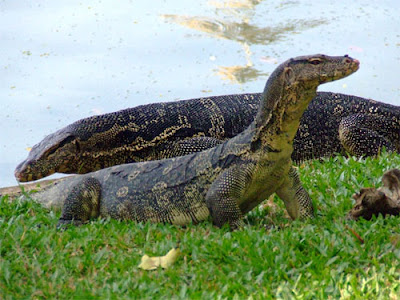The Varanus salvator population from the Central Indonesian island of Obi, Maluku Province, is described as a new subspecies representing the most easterly confirmed occurrence of the widespread Southeast Asian water monitor lizard. The new taxon differs from the four recognized subspecies by unique characters of coloration and pattern such as a distinct dorsal pattern on the head in combination with reduced transverse rows on the anterior back which stand in contrast to the distinct and black-bordered, large light spots on the hind part of the body. In addition, the eastern border of the distribution range of the V. salvator complex is critically discussed in the light of historical voucher specimens from the Moluccas, New Guinea and even Australia.
 |
| Varanus salvator |
The Obi island recor which had long been published but has never since been scrutinized, confirms the recently observed sympatric occurrence of members of the V. salvator and V. indicus species groups on several islands of the Moluccas. Further field investigations are needed to understand the different niche occupation between both these ecologically similar monitor lizard groups. Once more, our findings demonstrate the importance of the Central Indonesian islands of Wallacea as a global hotspot of varanid diversity and endemism.
The Southeast Asian water monitor lizard Varanus salvator (Laurenti, 1768) is among the largest extant
squamate reptiles of the world. It is also the most widespread member of the genus Varanus (Böhme, 2003),
ranging from Sri Lanka in the west through continental Southeast Asia, the Greater and Lesser Sunda Islands to Sulawesi and the Moluccas (Koch et al., 2007a). However, taxonomy and intraspecific diversity of this giant Asian monitor lizard species complex have long been neglected. Anew era started in 2007, when the three traditionally recognized subspecies from the Philippine Archipelago were elevated to full species status due to significant morphological differences (Koch et al., 2007a). In another recent study, the Philippine species were reinvestigated morphologically and it could be shown that this vast archipelago harbors no less than five different species of the closely related V. salvator complex (Koch et al., 2010).
 |
| Varanus salvator |
Another unresolved issue is the exact limit of the distribution range of V. salvator and its occurrence on
the islands east of Sulawesi (see Koch et al., 2007a). De Rooij (1915), for instance, examined historical voucher specimens from Halmahera but also listed Bacan (Batjan) within the species range. Mertens (1930, 1942, 1959, 1963) reported V. s. salvator from the islands of Obi, Halmahera, and Bacan at the eastern boundary, although no material from either of the latter two islands was available to him. Instead, he referred to earlier authors like Bleeker (1856, 1857, 1860a, 1860b), who had reported V. salvator from the Moluccas. Brandenburg (1983) adopted these earlier records from Halmahera and Obi. More recent authors, however, largely ignored the possible occurrence of water monitor lizards in the Moluccas (see, e.g., Eidenmüller, 2009).
Recently, however, populations of Varanus salvator were encountered on several Moluccan islands such as those of the Sula Archipelago and Obi (Weijola and Sweet, 2010). Subsequent investigations of the varanid collection at the Senckenberg Museum, Frankfurt (SMF), revealed one juvenile specimen of V. salvator from the island of Obi, which was donated by the Museum Zoologicum Bogoriense on Java, Indonesia, in 1957. This voucher specimen formed the base for Mertens’ (1959) novel island record for Obi. The specimen exactly matches in coloration and pattern with a live specimen from Obi as depicted by Weijola (2010). Due to unique characteristics in the color pattern of the Obi population, we here describe a new subspecies of the Southeast Asian water monitor lizard V. salvator.
Field work on Sulawesi and adjacent islands was conducted between 2005 and 2007. In addition, voucher
specimens of major European and Indonesian natural history museums were studied. Museum collection acronyms used follow Leviton et al. (1985).
Examination methods of standard morphometric and meristic characters used in this study are based on
the works of Mertens (1942), which were later further developed and expanded by Brandenburg (1983) and
Böhme et al. (1994). For each voucher specimen examined 21 external morphometric and meristic characters
were recorded. In order to minimize the errors based on observer bias, all measurements and scale counts were made by the senior author. In addition, four proportion indices were calculated. Character definitions and abbreviations used are listed in. Head measurements were taken with a slide-caliper to the nearest
1 mm.
Body and tail lengths of subadult and adult specimens were taken with a measuring tape. Scale counts
were recorded using pins and with check marks. A binocular microscope or a magnifying-glass was used for
juvenile specimens with very small scales. For the measurement of the scalation character Q, the first continuously tail-spanning row of scales near the tail base was counted by excluding the first rows immediately after the cloaca, which form a non-continuous bow.
The transverse scale rows on the ventral side to the insertion of the hind limbs (character T) were counted up to the last continuous row when the scales eventually decrease and are of irregular shape. In contrast to Brandenburg (1983) and Böhme et al. (1994), “N” instead of “n” abbreviates the number of gular scales from the tip of the snout to the gular fold, to avoid confusion with the stan-dardized variable “n” for the number of voucher specimens examined.



 11:52 PM
11:52 PM

 Posted in:
Posted in: 





0 comments:
Post a Comment